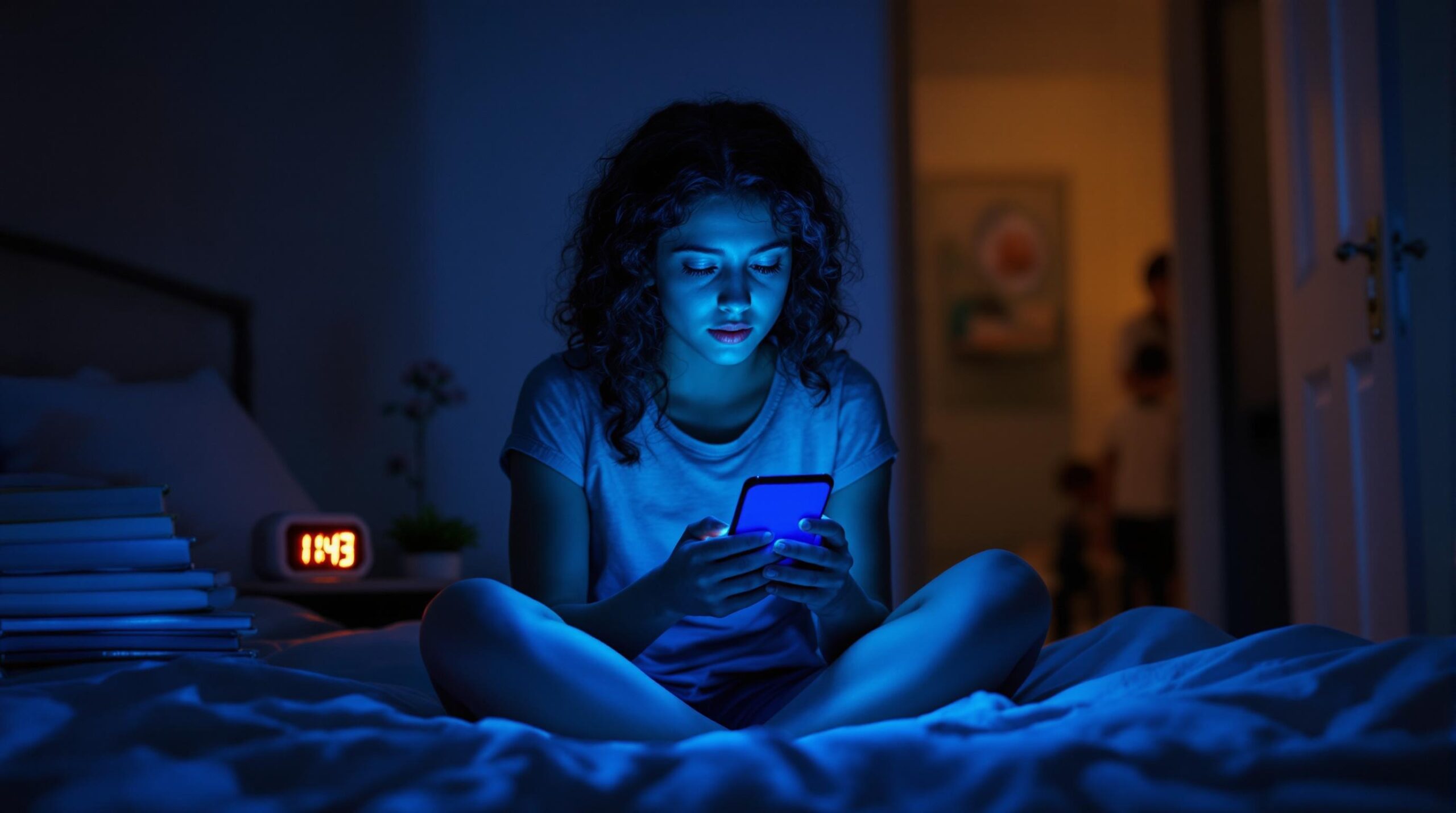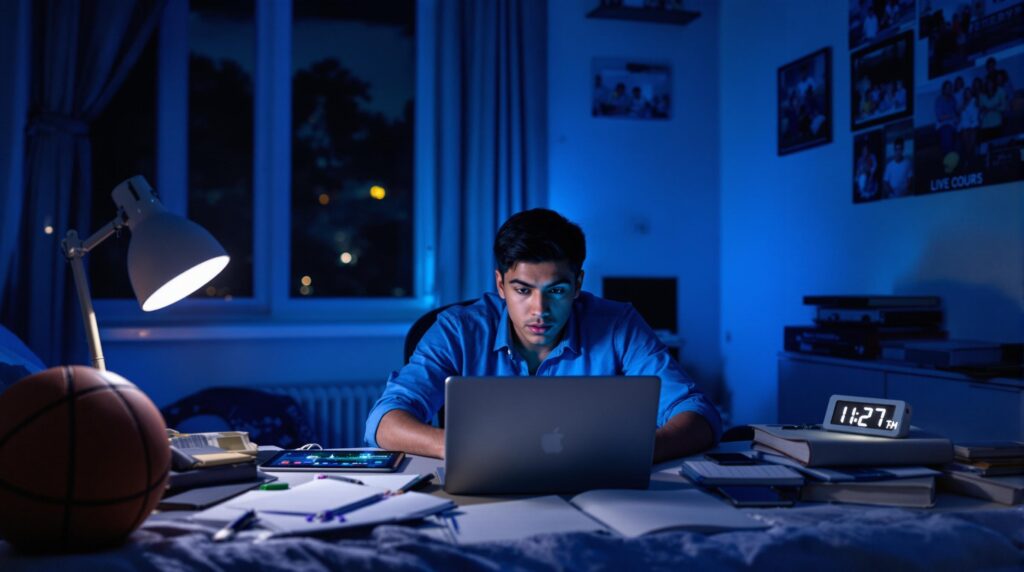Table of Contents
ToggleThe Digital Dilemma: Understanding Screen Time for Teens
Parenting teenagers in today’s hyper-connected world presents unique challenges that past generations never faced. When I talk with parents in my practice, screen time consistently tops their list of concerns. But what exactly constitutes “screen time” and how much is appropriate for adolescents?
Screen time encompasses all time spent interacting with electronic devices with screens—televisions, computers, smartphones, tablets, and gaming consoles. Not all screen activities are created equal, though. Passive screen time involves consuming content without much interaction (like watching TV shows or YouTube videos), while interactive screen time requires engagement and response (such as playing video games, creating digital content, or scrolling through social media).
The American Academy of Pediatrics (AAP) suggests teenagers (ages 13-18) should limit recreational screen time to 1-2 hours per day of high-quality educational programming. This recommendation stands in stark contrast to reality—the average American teen spends nearly 7 hours daily on entertainment screen media, excluding time for homework or educational activities.
Understanding these distinctions helps parents make informed decisions about setting appropriate limits. The type of content matters just as much as the quantity—an hour spent on educational programming differs substantially from an hour spent doom-scrolling through social media feeds or watching mindless content.

Physical Health Risks of Excessive Screen Time
The correlation between extended screen use and physical health concerns has been extensively documented in recent years. These health impacts range from immediate effects to potential long-term consequences.
Sedentary Lifestyle and Obesity
One of the most obvious impacts of excessive screen time is how it contributes to a sedentary lifestyle. Every hour teens spend on devices typically represents an hour they’re not physically active. The Centers for Disease Control and Prevention (CDC) has found that teenagers spending more than 4 hours daily on screens face a significantly higher risk of being overweight or obese.
This sedentary behavior creates a troubling cycle: as teens become less active, they gain weight, which can make physical activity feel more challenging, leading to even more screen time. Some parents have shared with me that their once-active children gradually reduced sports participation as their screen time increased, with noticeable changes in energy levels and physical fitness.
For example, a 15-year-old who formerly played soccer three times weekly might gradually reduce participation to once a week as screen time increases, eventually quitting altogether. The repercussions extend beyond weight—cardiovascular health, muscle development, and bone density can all suffer from extended periods of inactivity during these crucial developmental years.
Sleep Disruption and Deprivation
Perhaps most concerning is the impact of screens on adolescent sleep patterns. The blue light emitted from screens suppresses melatonin production, the hormone responsible for regulating sleep cycles. Using devices before bedtime can delay sleep onset by up to an hour or more.
Teenagers need 8-10 hours of sleep nightly for optimal development, yet many are getting far less. Sleep deprivation doesn’t just lead to tiredness—it affects mood regulation, academic performance, and even immune function. The CDC reports that insufficient sleep is associated with increased risk-taking behaviors in teens, including substance use and dangerous driving.
Parents can help by establishing a “device curfew” where all electronics are turned in 1-2 hours before bedtime. This transition period allows the brain to begin producing melatonin naturally and prepares teens for restful sleep. Setting healthy screen time boundaries doesn’t just improve immediate sleep quality—it helps establish lifelong healthy sleep habits.
Visual and Musculoskeletal Issues
Extended screen use can also contribute to digital eye strain—a constellation of symptoms including dry eyes, headaches, and blurred vision. Many teens report experiencing these symptoms yet continue their screen use without taking breaks.
Additionally, poor posture while using devices can lead to neck, shoulder, and back pain, sometimes called “tech neck.” These postural issues, if left uncorrected during adolescent development, can lead to chronic pain patterns that persist into adulthood.
Encouraging the 20-20-20 rule (looking at something 20 feet away for 20 seconds every 20 minutes of screen time) can help reduce eye strain. Similarly, teaching proper ergonomics and reminding teens to change positions frequently can minimize musculoskeletal complaints.
Mental Health Concerns: Depression and Anxiety
The relationship between screen time and teen mental health represents one of the most significant concerns for parents and health professionals alike.
Depression and Mood Disorders
According to research from the National Institute of Mental Health (NIMH), excessive screen time shows troubling links to increased symptoms of depression in adolescents. Their studies indicate teenagers spending more than 3 hours daily on screens demonstrate a higher likelihood of experiencing depressive symptoms than peers with lower screen usage.
This connection isn’t merely about time displacement—though replacing in-person social activities with screen time certainly plays a role. The content teens consume also matters tremendously. Social comparison, cyberbullying, and exposure to idealized or unrealistic portrayals of others’ lives can fuel feelings of inadequacy and sadness.
Parents should maintain open communication with teens about their online experiences. Asking specific questions about how they feel during and after screen use can uncover potential concerns. For instance, does scrolling through Instagram leave them feeling energized or depleted? Do they feel better or worse after spending time on certain platforms?
Anxiety and Stress Response
The NIMH research also highlights connections between excessive screen time and anxiety symptoms. The constant notifications, pressure to respond immediately, and fear of missing out (FOMO) create a state of perpetual alertness that can trigger anxiety responses.
For example, many teens report feeling anxious when separated from their phones—a phenomenon sometimes called “nomophobia” (no-mobile-phone-phobia). This anxiety can manifest as irritability, restlessness, or difficulty concentrating on non-screen activities.
Implementing regular digital detox days for teens can help reset unhealthy patterns and demonstrate that life continues quite happily without constant connectivity. These breaks provide valuable opportunities for teens to reconnect with non-digital interests and rediscover activities that bring authentic joy rather than brief dopamine hits.
Social Skills and Relationships: The Impact of Digital Interactions
While technology offers unprecedented connectivity, it paradoxically can inhibit the development of fundamental social skills when used excessively.
Development of Face-to-Face Communication Skills
The U.S. Department of Health and Human Services (HHS) notes that teenagers who spend excessive time on screens—particularly social media—often struggle with real-time, face-to-face communication. Crucial nonverbal cues like facial expressions, tone of voice, and body language aren’t adequately learned through digital interactions.
These in-person communication skills aren’t innate—they develop through practice. Teens who primarily communicate through text messages or social media may miss opportunities to develop these essential abilities. Parents report their teenagers sometimes struggle with making eye contact, continuing conversations without checking their phones, or reading emotional cues in social situations.
Encouraging regular tech-free family meals, participating in group activities, and limiting phone use during social gatherings helps teens develop these fundamental skills. The benefits extend far beyond adolescence—these abilities form the foundation for future professional relationships, romantic partnerships, and community connections.
Quality of Relationships
The quantity of digital connections rarely translates to quality relationships. HHS research indicates teenagers with high social media usage often report feelings of loneliness despite having hundreds or thousands of online “friends.” This paradox highlights the qualitative difference between authentic relationships and digital connections.
The superficial nature of many online interactions fails to provide the emotional depth and support that in-person friendships offer. True intimacy develops through shared experiences, vulnerability, and presence—elements often absent in digital communications.
Parents can help by creating opportunities for teens to engage in meaningful in-person social activities and by modeling healthy relationship behaviors themselves. Social media’s impact on teen self-esteem becomes less pronounced when balanced with authentic relationships that provide genuine validation and support.
Academic Performance: Balancing Screens and Studies
The academic consequences of excessive screen time have become increasingly apparent as digital devices have proliferated in teens’ lives.
Focus and Concentration Challenges
Constant exposure to fast-paced digital content can rewire attention patterns, making sustained concentration on less stimulating academic tasks more difficult. The National Center for Education Statistics (NCES) has found that teenagers spending more than 2 hours daily on recreational screens tend to have lower grades and test scores.
This effect stems partly from the brain’s adaptation to frequent dopamine releases associated with social media notifications, gaming rewards, and rapidly changing content. These quick hits of stimulation make the slower, more methodical work of studying seem comparatively unrewarding by contrast.
Many teens struggle with what researchers call “continuous partial attention”—trying to focus on homework while simultaneously responding to messages or checking social media. This divided attention significantly reduces information retention and comprehension.
Parents can help by creating screen-free study environments and teaching time management skills that incorporate focused work periods followed by brief screen breaks. These structured approaches help train the brain to sustain attention while still acknowledging the appeal of digital rewards.
Time Management and Academic Priorities
Beyond attention issues, excessive screen time simply displaces hours that could be spent on academic pursuits. Every hour devoted to recreational screen activities represents time not spent on homework, reading, studying, or engaging in enrichment activities that build academic skills.
The NCES findings show this time displacement has tangible consequences: lower homework completion rates, reduced reading proficiency, and decreased engagement in extracurricular activities that support academic growth.
Helping teens track their actual screen time (most devices now offer this feature) can be eye-opening. Many are genuinely surprised to discover they spend 5+ hours daily on their phones alone. Creating a visual breakdown of how they spend their 24 hours often highlights imbalances and creates motivation for change.
Finding Balance: The Benefits of Moderate Screen Use
While excessive screen time presents clear risks, it’s equally important to acknowledge that moderate, intentional screen use offers genuine benefits for teenagers.
Educational Opportunities and Digital Literacy
The digital landscape provides unprecedented access to knowledge and learning opportunities. From interactive educational apps to online courses taught by world-class experts, screens can facilitate learning experiences impossible in previous generations.
Digital literacy—the ability to find, evaluate, and create content using technology—represents an essential skill for future success. Teenagers who learn to leverage technology for research, creation, and collaboration develop valuable competencies that transfer to academic and professional settings.
Parents can guide teens toward quality educational content and teach critical evaluation skills. Discussing how to assess online information sources, recognize misinformation, and use digital tools productively transforms passive consumption into active learning.
Some screen time offers benefits when it’s purposeful rather than habitual—the difference between actively learning a new skill via YouTube tutorials versus mindlessly watching whatever the algorithm suggests next.
Creativity and Self-Expression
Digital platforms provide unique avenues for creative expression and identity exploration. Whether through creating digital art, producing music, writing blogs, or making videos, teens can develop and showcase talents in ways previous generations couldn’t imagine.
These creative pursuits build technical skills while fostering personal growth, self-confidence, and even career exploration. Many teenagers discover passions and potential career paths through digital creative endeavors.
Encouraging this productive screen use means showing interest in teens’ digital creations and helping them find communities that support their interests. The difference between a teen spending three hours mindlessly scrolling versus three hours creating digital content is enormous in terms of developmental benefits.
Parental Guidance: Setting Healthy Screen Time Limits
Successfully managing teen screen time requires thoughtful parental involvement that acknowledges both the realities of digital life and developmental needs.
Creating a Family Media Plan
The AAP recommends every family create a personalized media plan that establishes clear expectations about screen time limits, content guidelines, and device-free zones or times. This collaborative approach works better than arbitrary rules imposed without explanation.
An effective family media plan addresses:
- Screen-free times (meals, before bedtime, during family activities)
- Screen-free zones (bedrooms, dining areas)
- Content guidelines and privacy settings
- Balance between screen activities and other important aspects of life
- Consequences for not following the plan
Involving teenagers in creating these guidelines increases buy-in and teaches valuable self-regulation skills. Regular family discussions about digital citizenship—responsible, ethical technology use—further reinforce healthy habits.
Modeling Healthy Technology Use
Perhaps the most powerful strategy for influencing teen screen habits is modeling appropriate behavior. Teenagers remain highly attuned to parental example, regardless of their protests to the contrary.
Parents who constantly check their phones during conversations, bring devices to the dinner table, or react immediately to every notification demonstrate priorities that contradict their stated values about screen moderation.
Conversely, parents who set their own device limits, maintain screen-free spaces in their homes, and demonstrate engagement in non-digital activities provide powerful examples of balanced living.
This modeling extends to how parents handle their own social media use, online privacy, and digital boundaries—all behaviors teens observe and often emulate despite appearances to the contrary.
Gaming and Entertainment Considerations
Video games and entertainment apps present unique considerations within the screen time discussion. Video games impact teen mental health in complex ways—they can build problem-solving skills and provide social connection, but also risk addictive patterns that displace other activities.
Parents should consider both quantity and content when evaluating gaming habits. A teen spending two hours playing strategy games with friends differs substantially from one playing violent first-person shooters for six hours in isolation.
Understanding game ratings, content warnings, and using parental controls helps ensure age-appropriate experiences. Equally important is maintaining ongoing conversations about gaming habits—asking teens what they enjoy about certain games, observing how they feel during and after playing, and noticing any changes in mood, sleep, or other activities.
Finding the Right Balance for Your Teen
The ideal screen time balance varies based on individual factors including age, maturity level, specific content consumed, and how screen use affects other aspects of life. Rather than focusing exclusively on hours, parents should consider the bigger picture of teen well-being.
Signs that current screen habits may need adjustment include:
- Declining grades or incomplete homework
- Sleep disturbances or daytime tiredness
- Reduced participation in previously enjoyed activities
- Irritability when asked to disconnect
- Social withdrawal from in-person relationships
- Physical complaints like headaches or eye strain
The goal isn’t elimination but equilibrium—helping teenagers develop healthy relationships with technology that enhance rather than detract from their development. By maintaining open communication, setting thoughtful boundaries, and modeling balanced technology use, parents can guide teens toward digital habits that support rather than undermine their physical, mental, and social well-being.
Remember that adjusting screen habits often requires patience and persistence. Small, consistent changes typically prove more effective than dramatic restrictions that trigger resistance. With thoughtful guidance, teenagers can learn to harness the benefits of digital connectivity while avoiding its pitfalls—a skill that will serve them well throughout their lives.
Sources:
American Academy of Pediatrics. (n.d.). Media Use in School-Aged Children and Adolescents.
Centers for Disease Control and Prevention. (2022). Adolescent and School Health.
National Institute of Mental Health. (2022). Depression in Children and Adolescents.
U.S. Department of Health and Human Services. (n.d.). Social Media Use and Mental Health: A Systematic Review.
National Center for Education Statistics. (2022). Student Reports of Bullying and Harassment: Results From the 2019 School Crime Supplement to the National Crime Victimization Survey.












